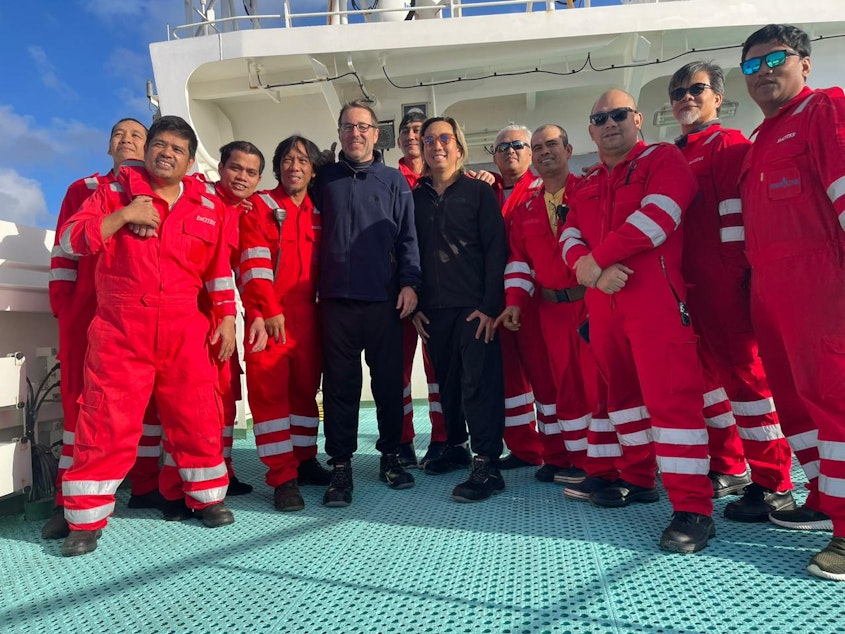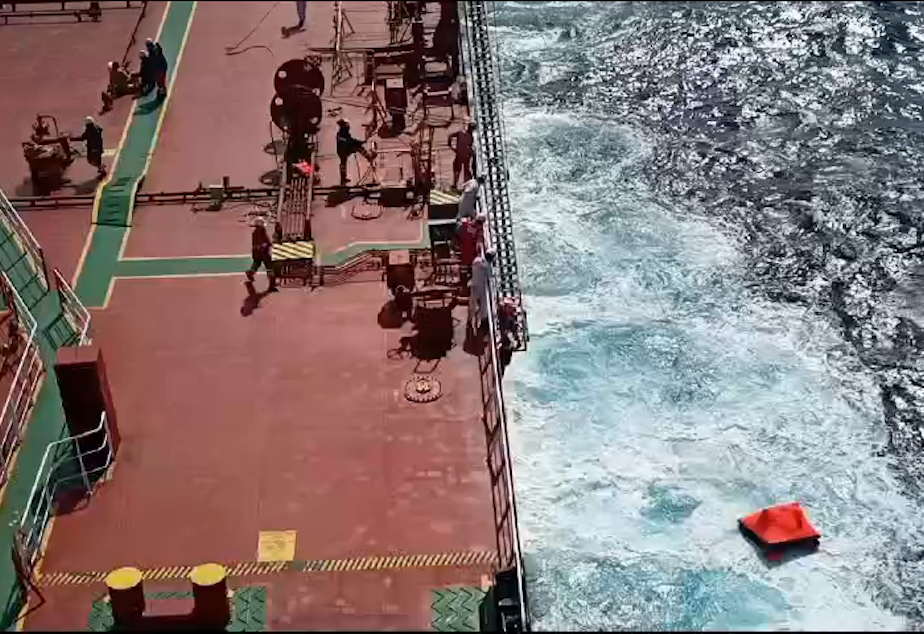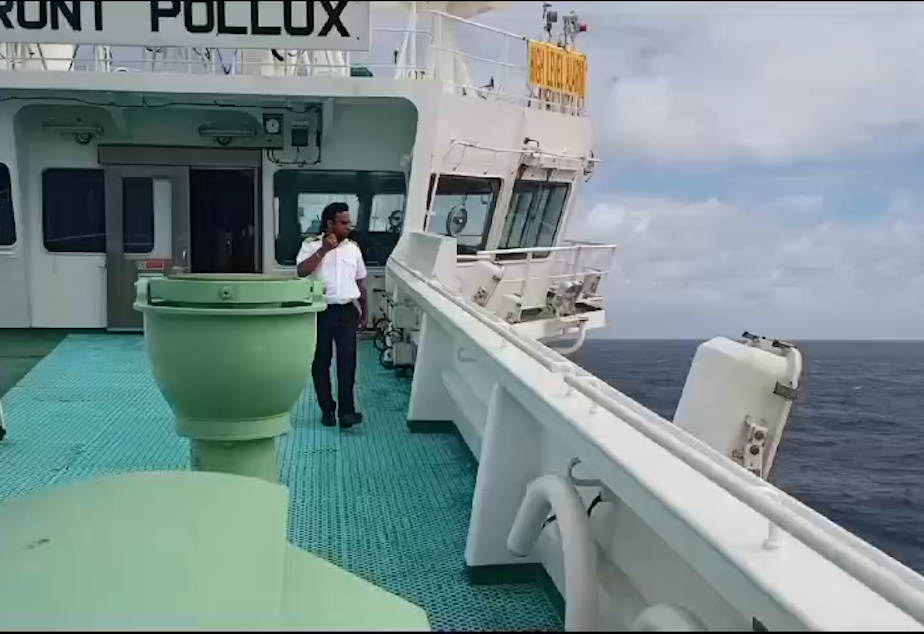Rescue at sea: A Mercer Island man's harrowing account of courage and luck in the South Atlantic

Balthasar Wyss of Mercer Island was rescued in March in the south Atlantic Ocean after the sailboat he'd been on sank. This is his account of what happened, as told to KUOW's Angela King.
I’ve been interested in sailing since I was a young kid. I’ve longed to go on adventures, like Robinson Crusoe, to remote islands.
In January, I took a career break. I found a boat, which you can do on Facebook, where there are sailing groups, or a site like findacrew.com. I joined a crew crossing the southern Atlantic Ocean, going from Rio de Janeiro in Brazil to Cape Town in South Africa.
Benno Frey was the captain — a Swiss guy who sailed for 40 years. The other crewmember was Marcelo Osanai of Sao Paulo, Brazil. He was in his 30s.
We left on February 27. The weather was perfect. We swam in the ocean, which was eerie — 15,000-plus feet below you of deep and nothing else. We caught fish and ate fish tacos and sushi on board. We had a great time.
We arrived at Tristan de Cunha, a small, Jurassic Park-like island in the middle of nowhere. It's part of the U.K., so you get a stamp from the U.K. when you stop there. About 180 people live on that island.
Sponsored
When we got there, we provisioned and got diesel, and then downloaded the latest weather forecast, which predicted a massive storm. We knew we had to leave the island, because it didn’t have a protected harbor.
The next day, at 6 p.m., I woke up after a nap and heard my roommates talking. I went into the main cabin.
I saw water in the bilge. We tried to get the water out, and we put in a second pump, but it didn't help. The water slowly got higher.
The storm was massive. Picture 40-knot winds and water coming over the boat, with waves that were 25 feet.
When Marcelo noticed that the front right rail had been ripped off, we realized this was serious. Around midnight, we triggered an alert SOS. It went through a satellite, and immediately a global rescue operation started, involving the coast guards of Uruguay, the U.S., and South Africa.
Sponsored
We weren’t on a tanker route, which would typically mean there would be no tanker for thousands of miles. But luckily, there was a tanker relatively close — the Front Pollux, a massive oil tanker with 60-feet high steel hulls. The captain immediately diverted his oil tanker to find us.
Back on the sailboat, we were in problem-solving mode. I thought a lot about my wife and my kids. It gave me incredible strength not to give up, and to fight and do my best to get through. Hope is an incredible force. If you have hope, you can do incredible things, and stay focused. If you believe that you have a chance to get through, it gives you a tremendous energy.
Obviously, there were also dark moments, when I wondered, "How am I going to die? Am I going to float out in the ocean and freeze? Or will I just drown?”
The next morning, we realized it was time to go. The water was at our hips in the cabin. We went outside to the deck, and we prepared the life raft.
We threw it in the water, and it inflated properly. It looked like a small red tent, with an opening on one side.
Sponsored
Captain Benno pulled it in. He was very strong, and it took some effort, especially with 25-foot waves.
I unclipped myself and jumped headfirst into the life raft. Inside was a box with flares and food and water. There were also thermal mats to keep us warm. The hole of the life raft faced away from the boat, so I couldn’t see what was happening to the sailboat.
Marcelo was in the water, hanging onto the raft. I said to him, “Come immediately into the life raft.”
He stared blankly, and I knew something must have happened. He eventually jumped into the life raft.
I asked him, “Where’s Benno? Where’s the captain?” And he said simply, “He’s dead.” He didn’t say more than that.
Sponsored
Normally, I would ask, “What happened? Can we help him? Let’s see if we can rescue him.” But none of that happened. I was just trying to survive.
Later, Marcelo told me that the captain, who was also clipped in, tried to unclip himself from the rail of the boat. When he wasn’t able to, he tried to unclip himself from the life vest, and that didn’t work either. He was literally pulled down with the sailboat.
He gave his life to save his crew. It's just that simple. And that's very hard to swallow.
O
nce the life raft was closed, it felt very safe. Occasionally we were thrown in the opposite corner, because a wave would crash over us. But the raft always righted itself.
Sponsored
We got a message through a satellite device to say a boat was three hours away.
But after three hours, nothing happened.
We sent them a message, asking for an ETA. We had to be very careful with these messages, because at that time, the device was down to 20% battery power.
We ultimately drifted for about five and a half hours, 18 miles or so from the sailboat, even though the life raft had an anchor to slow the drifting.

 25 secs
Footage of the Front Pollux oil tanker arriving to save the life raft containing Balthasar Wyss of Mercer Island, Washington, and Marcelo Osanai of Brazil.
25 secs
Footage of the Front Pollux oil tanker arriving to save the life raft containing Balthasar Wyss of Mercer Island, Washington, and Marcelo Osanai of Brazil.
During this time, we got a message through that device. Just one simple message. Somebody asked us, “How are you doing?” I will never forget this, when you're moments from dying, and there's somebody out there who cares for you.
And then we heard a horn. We looked at each other like, “Are we dreaming here, or is this real?” We later learned they’d been honking for hours, but this was the first time we heard it because the ocean was so rough.
Four people had been scanning from the bridge of the oil tanker, and at some point, they saw a little red dot out in the ocean.
Marcelo opened the life raft and looked outside. He turned back to me and said, “Oh, this is a big boat.”
I immediately had two thoughts. One, that's great news because big ships usually have rescue material and rescue procedures and skills. But on the downside, how do we get up a 60-foot steel wall in rough seas?
The captain was very smart. He didn't just go to the location where the sailboat sank, but with his navigation team, started running calculations based on the current and winds to figure out our location. They steered the ship toward where they thought we would be and eventually picked up our signal.
It takes an oil tanker that size probably half an hour to get to a full standstill. The captain approached us very slowly and gingerly. At the end, he turned his massive tanker skillfully so that we were protected from the worst of the current and winds.

 17 secs
Video captured of the rescue of Balthasar Wyss of Mercer Island and Marcelo Osanai in the south Atlantic Ocean in March 2024.
17 secs
Video captured of the rescue of Balthasar Wyss of Mercer Island and Marcelo Osanai in the south Atlantic Ocean in March 2024.
They threw us multiple lines. We were eventually able to tie one line to the life raft.
They lowered a cage to pick us up, but that banged so much against the hull that it was too dangerous. So they pulled that up and used a ladder system instead.
We had to time it, so when the wave carried us up, we would jump and grab the ladder, and then as quickly as possible climb up the ladder.
When I was halfway up, the head of the deck crew, an incredible guy, smiled at me. At that point, I knew, I was going to be OK.
This account comes from an interview transcript that was edited for clarity. Produced for the web by Isolde Raftery.





